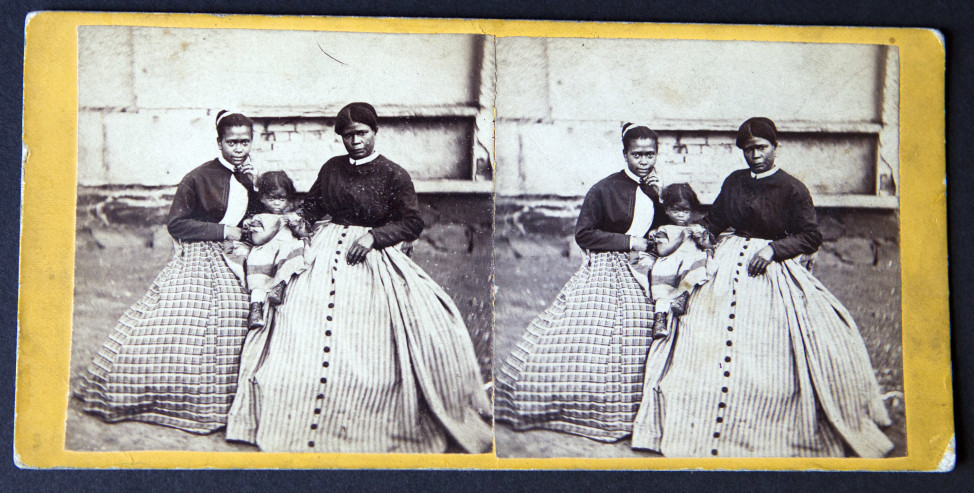
Rare photo of Selina Gray (far right in both images), a slave owned by Confederate Gen. Robert E. Lee. (AP Photo)
One hundred and fifty-three years ago this September, President Abraham Lincoln issued the Preliminary Emancipation Proclamation declaring his intention to free all slaves in the rebellious states if the South did not end the fighting and rejoin the Union by Jan. 1, 1863.
At that time, the country was embroiled in the U.S. Civil War, a conflict over the power of the federal government and the role of slavery in American society. Lincoln, the first Republican president, was elected in 1860 after pledging to keep slavery out of the territories that hadn’t become states yet. The seven Southern slave states seceded and formed their own nation, the Confederate States of America.

Old slave market in St. Augustine, Florida (Library of Congress)
Estimates vary, but between 620,000 and 750,000 died during the bloody conflict.
When the Civil War ended on April 9, 1865, the Union forces had proven victorious and as a result, more than four million enslaved Americans were given their freedom. A more powerful, centralized federal government was also established.
Slavery first came to the North American continent in the 17th century when a Dutch ship carrying African slaves arrived to the New World. The ship came at a time when the colonies were in dire need of labor to work the land.
By the American Revolution, it’s estimated that 3 million captured Africans had been brought to the Americas by English importers.
Slavery eventually died out in the North, but in the South, the institution of enslaving people was integral to the cotton industry, a mainstay of the regional economy. However, in 1807, Congress banned the importation of slaves.
The 1857 Dred Scott Supreme Court decision affirmed that slaves and their descendants were not U.S. citizens and therefore had no rights as citizens, even though free black men in some of the original U.S. states had been full voting citizens since the Declaration of Independence in 1776. The Dred Scott decision widened the gulf between the North and the South ahead of the Civil War.
An 1855 slave action brochure (partially pictured below) contains listings of entire families that were up for sale in New Orleans, offering graphic insight into the slavery trade.
This particular group of enslaved Americans was being sold by the heirs of their deceased owner. The pamphlet lists parents and their children together and stipulates they be sold as a family group. The state of Louisiana required that very young slave children be sold along with their mothers.
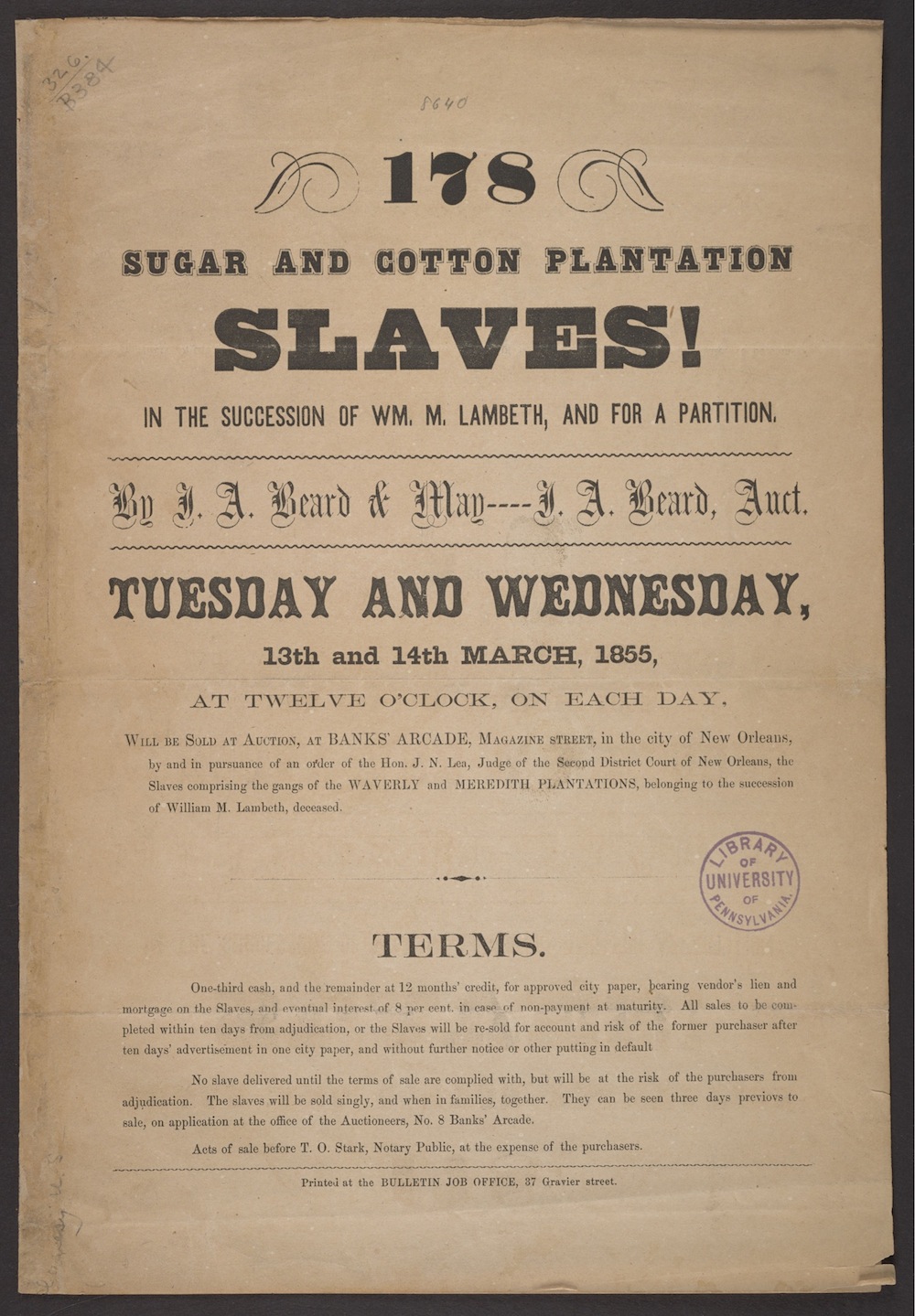
An 1855 pamphlet from J.A. Beard & May in New Orleans (University of Pennsylvania Libraries)
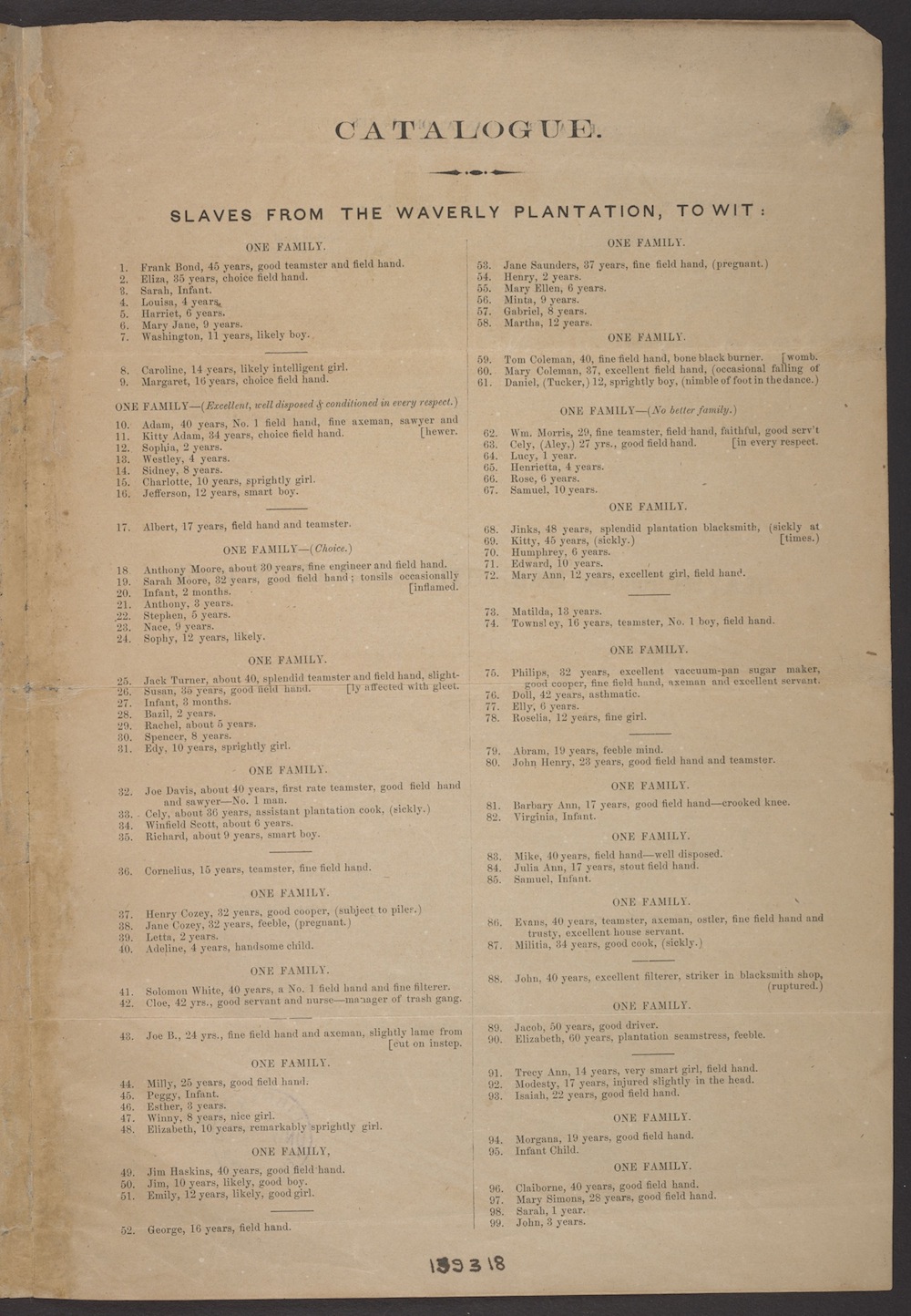
An 1855 pamphlet from J.A. Beard & May in New Orleans (University of Pennsylvania Libraries)











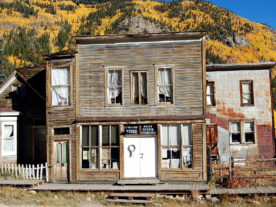
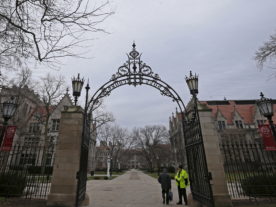












When is America going to ” ante up and kick in” admit to it’s sorted past and ask for forgiveness. The Romans never did, look what happened to them…The Germans have and look how they are prospering….America,,,do the right thing…
L
America will only ante up to send all blacks back where they came from-Africa ASAP. Forced Integration in America for the last 51 years was never the right thing. Diversity is perversity .Inclusion ,acceptance, equality tolerance and multiculturalism are myths that have never worked anywhere , and never will in America.
Unless you are Native American then you too, should return from whence you came.
I came from the Bronx. Last time I checked a map that was in America so I’m a native born American. Where did you come from? I don’t want to go back to the Bronx. I prefer it here in rural New Jersey. Are you opposed to all immigrants? Are you opposed to illegal immigrants? Are you even an American yourself? Why should anyone pay attention to such absurdity as yours?
They paid attention to your glaring ignorance didn’t they. Your ancestors came from elsewhere to the Bronx silly.
I don’t get your point Dee. Everyone came from somewhere else unless they are where human life is believed to have evolved, the rift valley in Africa. Native Americans are believed to have migrated to the Americas from Siberia across a land bridge to Alaska in the last ice age about 15,000 years ago. Their only claim is that they came here before I did. Modern genetic research supports this theory as Native Americans have genes closely associated with Eurasians. So you have the theory that those who came before have the right to shut the door behind them and keep everyone else from coming here, is that how you see it? Don’t hold your breath, the other 315 million of us in the USA are not about to pack up and go to who knows or cares where. WE are here now and that is all that matters.
No, we are not complaining that we were forced here against our wills-blacks complain that-they can go to Liberia, that was set aside just for them if they don’t want to assimilate here in the USA-victim mentality=boring, played out argument.
Even so called “native” Americans should go back where they came from. While they’re at it, have them stop killing themselves off as they did during their tribal wars.
Basically, if you’re going to post something, have some idea of what you’re talking about.
The Indians must leave to, do you actually think they lived here since the beginning of time, a white culture existed here before them. It has been scientifically proven.
I rather think that the US should ship away/back the imported bigots you seem keen to represent, nothing good nor decent is coming from this kind of nonsensical and pitiful disgrace to human kind.
American society is not based on multiculturalism the way Europe is. It is based on a melting pot theory where there is a shared set of values and a core culture which may have many expressions but are all tied back to the same basic values. America is by far the most successful experiment where people from diverse backgrounds can live together in relative peace. Just look at the rest of the world if you don’t believe it.
American belongs to Native Americans……. So you and your racist fellows must also be kicked out of America
This is the most remedial drivel of an old tired argument…! “Who’s the most American; I’m more of an American than you people!” Stop already! The only “true” American to me is one that embodies the ideals of his great country, wants to assimilate, wants to learn and speak English, desires to follow our laws, has respect for our laws and, wants to contribute in a socially positive way.
When the argument is phrased in this way, one can begin to understand what the so-called “white people” are so mad about….
Feel free to go be savage-like where YOU come from…..not in America….America is so much better of a place than so many other places on earth…..for so many reasons…!
Why should they have to speak English? English is not our official language. We don’t have one.
Liberia was set aside for repatriation of slaves-let them have that!
Actually, this country belongs to blacks. We were here 150 years before anyone else. So if you want to talk about anyone leaving, let’s talk about all the Europeans. The only reason ya’ll landed on plymoth Rock was because the Britts didn’t want you anyway.
No need for that, there are no LIVING survivors of slavery left-they are the only ones who would deserve an apology.
If you wait long enough to do the right thing, everyone involved will be dead. So what’s you point?
The point IS there are no living survivors of slavery due any reparations or apologies-get over the victim mentality-it is pathetic.
What do you mean “Own Up?” My family has been in what is now North America from before there was a US, do I owe?
No one owes, just more thugs crying victim-I do not feel guilty or in debt to these people-they kill each other at an incredible rate everyday-I don’t even take anything they say seriously.
Yet it was and is WHITE America who makes weapons of destruction and cries when everyone wants to play…When your drugs didn’t work in eradicating them, and backlashed into your neighborhoods its a concern…As you said the heathens are stupid but the whites are smart duh ! Sex, drugs and rock n roll is the end and be all of your demise…lol ! This is your punishment for being so greedy and lazy for bringing people to UR country enslaving them. Every thing when cornered will fight back…Your forefathers did this to them selves … Besides. You/your ancestors moved out the blacks and moved in and took their home as well Africa…
P.Hill you are really a piece of work, not a fine piece.
Don’t pity the Romans they had a good thing going for a thousand years, the eastern empire (who considered themselves an extension of the Roman Empire) went on for a thousand more years.
Keeping familys intact was not usually a consideration or so it is said.
If my Irish ancestors had been worth a fig as slaves, fewer of them would have starved to death in the potato famines of the 1840’s and been buried in mass graves. There are a lot of fates that are worse than slavery… Two more I can think of are drug addiction, prostitution, wage slavery and mercenary work. I’d rather be dead.
Excellent point. But…slavery was brutal and immoral all by itself despite the fact that many slept under roofs and had beds.
You mean despite the fact of watching your young daughters raped or being raped constantly. Watching your children or men killed as sport. Oh, you mean despite the fact of having your infants or little ones ripped from your arms, never to be seen again. Oh yeah, there are worst things than death. Death meant peace and freedom for slaves.
Sooo…your point is…?
Are you trying to point out that people don’t really appreciate that slavery was as bad as it was…? Cuz, if that’s your point, save it. It’s tired. Slavery sucked. Everyone knows that. Slavery’s legacy for blacks is entrenched victimhood…and that really sucks
Blacks are the only ones that can “unentrench” themselves by stopping all the victim rhetoric, pulling up their pants, getting an education and getting a job. Anything else is what sucks, and that is your choice and no one else’s.
Then why are black people raping, looting, killing, drug dealing to their own people-when that all stops then maybe I will take them seriously-don’t worry about 150 years ago, worry about 5 minutes ago-some black was shot, stabbed, raped, drugged-worry about that.
Go find the slave owners and ask them to apologize! Leave the rest of us alone as we had nothing to do with it!
Your Irish ancestors who came to America during the potato famine in Ireland were reportedly among the most racist anti black people in the US during the War Between the States. Read their history and find out.
Potato famine is pretty much a stretch, deaths you allude too is due primarily to English agrarian practices where the tenet farmers didn’t own their product. That product was exported to its owners in England. Tenet farmers (little better than slaves) had at most, very small plots of land for their own use.
Linda is a fool….. America long ago corrected its mistakes of the 1800s….black people just still use slavery and false claims of racism as a crutch in life!
Ludicrous, 150 years out of slavery. There are people over 100 still alive. Right to equal education 1964,about 49 years, right to vote, 1965 50 years, discrimination in housing, employment, and enforcement of the laws. Overt until about 1985,still a problem So you abuse,use murder and rape for hundreds of years and then after you have f’d us up say it’s our fault? Far worse than Nazis.
so true Linda, so True.
Very true Linda, it is easier to sit on the curb and cry that they are a victim then it is to stand up, pull your pants up, go to school and get a job. 150 years later and the victim/slave/race card is played out.
So then how about doing a story on the source of these black slaves? For hundreds of years before Europeans reached Africa the black tribes and nation states of Africa had a thriving slave trade to the point that several African nation state’s primary exports were their fellow blacks as slaves. To a lessor extent there was the Arab slave trade up north, but then the primary source for that trade were also blacks. After the Europeans arrived the black Africans were all too happy to add a new customer to their trade. Even after Europeans started to take over regions of Africa the primary persons responsible for capturing black natives were their fellow blacks. Slavery is ingrained into African to such a extent that it still exists there today.
“When is America going to ” ante up and kick in” admit to it’s sorted past and ask for forgiveness. The Romans never did, look what happened to them…The Germans have and look how they are prospering….America,,,do the right thing… ”
I suggest you start with your reparations by tracking down the African tribes that captured their fellow blacks as slaves and then sold them for personal gain.
The fact that Germany has paid reparations has nothing to do with their economic development. Its due to their culture of hard work as compared to a country such as Greece where people think they can retire at age 50 and have the government pay for everything. It is also due to massive aid from the U.S. as opposed to East Germany which saw Russia disabling entire factories and shipping back East to Russia. Its also due to decades of American military protection and America’s nuclear umbrella.
Strange, but Germany also was made to pay reparations after World War I. Using your “logic” that would surely mean they thus prospered. But no, instead they were lead into massive economic failure with massive inflation where literally a wheelbarrow of money could not buy a loaf of bread. These World War I reparations then lead to the outbreak of World War II.
So sad to see that they do not teach history today or that you do not bother to learn about it as opposed to grabbing onto the latest catch phrase.
Excellent post Truth seeker, you nailed it, spot on!
What other countries did in the period of American slavery does not absolve the United States of its actions. Once the slaves were shipped to America whose responsibility was it to see that they were freed?
Abe Lincoln’s plan was to free them all to Liberia-too bad he didn’t live long enough to do that.
President James Monroe started repatriating ex-slaves back to Africa long before Lincoln. That’s why the capital of Liberia is called Monrovia. Repatriation was going on at least from the time of President Monroe (1817-1825). But strangely, Monroe had a hard time getting volunteers to return to Africa.
Once again a complex story is often distorted and oversimplified. “Vermont was the first territory in 1777 to abolish slavery but in 1780 Pennsylvania was the first state to enact a law beginning abolition of slavery, freeing future children of slaves. Massachusetts was the first state to abolish slavery outright in 1783.” (cited from ask.com) And so the abolition of slavery in the United States was an ongoing process that took nearly 100 years. Britain boasts that it abolished slavery ahead of America early in 1833. That clearly is only part of the truth.
Europeans in general and the British in particular brought slaves to America. It started almost immediately about a year or so after the establishment of the settlement at Jamestown. Britain created the cotton economy in the Southern Colonies in what was to become the USA to compete with Egypt. But it depended on the cheapest possible labor and so they established a slave trade. I’ve visited the British slave pens in Bermuda and the Caribbean and like everything else about slavery it was inhuman. When the US became independent the Southern states inherited that cotton economy where slavery was indispensable for success but for Northerners it was intolerable. The cause of the War Between the States also called the Civil War was not about the abolition of slavery but the federal government’s power to prevent its expansion into new territories in the West that would one day become states. It was the bloodiest war in American history that pitted brother against brother, father against son. Just about every family in both the North and South were affected by the war. Few know this but President Lincoln had a plan to return the freed slaves to Africa after the war.
The period subsequent to the end of the war known as The Reconstruction of the South was a most reprehensible time for America. The echoes of it are felt down through history to this very day. When will we be ever truly free from it? The South was “punished” in many ways and it was a bad mistake. The racial animosity whites felt for African Americans was one result. Resentment of the Northern States by the Southern States was another. Nor did Europe learn from America’s experience as it rarely learns even from its own mistakes. The cruel treaty of Versailles ending WWI virtually set the stage for WWII. It was the same blunder the Americans made with even more dire consequences.
Outstanding Reply Marcus And Very Factual
I guess we know where the history majors are.
Sorry to disappoint you but my training was in engineering. I do have an interest in many other areas including history.
Great reply Marcus!!!
Linda Kaye says “America,,,do the right thing” and “ask for forgiveness”
The Civil War was enough. Thousands of Americans died doing “the right thing” fighting to free the slaves. They don’t need to ask for forgiveness. They need our thanks and honored remembrance. Their blood shed was more than enough atonement for America’s past sins. Remember the Battle Hymn of the Republic? Its original lyrics: “As he [Christ] died to make men holy, let us die to make men free.” They did so.
Free from what?
The actual death toll from the Civil War was well over 1 Million. The numbers cited in this article seem to be only the losses of the northern states.
Doesn’t anyone know their world history. Slavery dates back 4000 years on the record to Africa. Blacks invented slavery. It was depicted on the walls! Black tribes hunted other tribes in more modern times to sell the losers to the slave traders. That is just the way it was. Just like torture and murder were common in Europe through the 18th century! People alive today generally have better morals than those of the past. That’s what is called the growth of civilization. It is useless to blame the present condition on those living in the present. Blame the past and move on. People who think they are victims are victims of their own ignorance. Their culture cannot survive. Now the Black culture may actually be back in slavery as the Liberal Welfare State has made many Blacks totally dependent on welfare! That is racist; that is modern slavery. Obama is a leader in this effort. He isn’t doing anything to stop the drugs, the violence, the out of wedlock births, the destruction of Black schools by classroom disrupters, …. And the PEOPLE in these neighborhoods are doing nothing; they even vote for candidates who increase welfare and allow ignorance, violence, and unemployment to grow. So the real issue today is Black Slavery is back and Obama did it!
I just love how almost every of these comments were made by obvious racists trying to rewrite history to blame black people for the slavery: grotesque.
https://en.wikipedia.org/wiki/Slavery#Early_history
It is a fact of history that does not need re-writing-Africans sold their own into slavery-if you want reparations, go to Africa and get it from them, where it began.
It is also a fact of history that the British Empire was the greatest criminal enterprise in the history of the world, a savage gang on whose crimes they boasted the sun never set. Not that their counterparts from Spain, France, Belgium, Holland, and other nations of Europe were any better, they were just smaller. When I visited the gold factories in Toledo Spain, I wondered how much of the gold I’d seen was the result of the murderous genocide by the Spanish Conquistadors in South and Central America centuries ago. Genocide in the name of profit. Human beings and the wealth of the land ground up and put into in a monstrous industrial machine for the benefit of a handful of aristocrats and royalty in Europe. And ordinary people in those countries sent off in wars to die defending them and their booty or to steal others’. The slave trade and what came out of it was just one part of that machine. The beginning of the end of it started in Lexington and Concord in 1775 and ended with the final dismantling of those empires in the Trusteeship Council of the United Nations in New York City in the 1960s. Bretton Woods was another important step in reducing Britain down to what it could do for itself instead of what it could steal from the rest of the world. I find the British Crown and flag as reprehensible as I find the Confederate battle flag. Were I president, no royalty or others privileged blue blooded aristocrats would be allowed to step foot in the White House.
Who is worse, the seller of slaves or the buyer of slaves?
you are in denial how sad, you have created you some history, poor thing you, god has it all on his roll, that’s all the matters, you and your ancesters will pay and has paid.
Just compensation for slavery is/was required by the USA. That said there comes a point where compensation has been paid in full and that point I suspect has been reached. African Americans need to make their own way in life by following the example of those who have succeeded in the USA (including many Blacks). Education in central to getting a decent job. Family cohesion is very important for any community to prosper and find its place in the sun.
Slavery in America is a blot on US history. But it is a very old history (150 years old) and it is time for African Americans to move on (without of course forgetting that history). There are many American citizens living today who were slave laborers in Communist China, Soviet Union, Nazi Germany, Imperial Japan and under many dictatorships in South America and yes, Africa. We rarely hear anything about them. They do not use their terrible recent experiences as slaves as an excuse to commit violent crimes, set their own communities aflame, attack other communities, or sit on their duffs expecting to collecting welfare.
Don’t worry Kanye just announced his candidacy for the presidency in 2020…..
I’m sure he’ll make it all better….!
Reading the Constitution I don’t see anything that would legally prevent the Southern States from seceding from the Union. However, history is what it is and the US has been one country again for 150 years and will be very unlikely to ever break apart. As I see it, the Confederates were traitors to the USA and their battle flag belongs in a museum as it is as offensive to African Americans as the Nazi swastika is to Jews. It is a symbol of denial of their humanity.
Again, History is written by the victors of WAR.
America was the victor. The Confederacy was defeated. It no longer exists. We are all Americans who were born here or came here and became citizens. Are you defending the Confederate cause to maintain and extend slavery? That debate is over now. You’re a century and a half too late.
“When the Civil War ended on April 9, 1865, the Union forces had proven victorious and as a result, more than four million enslaved Americans were given their freedom.” Well, no. Slavery was finished when Pres Johnson signed the 13th Amendment, and thank goodness its over.
Please read “How Europe Underdeveloped Africa” by the late Dr. Walter Rodney, a Guyanese scholar who was the Chancellor of the University of Tanzania, in East Africa. Many of the comments on this forum have absolutely nothing to do with the wrongful enslavement of over twenty million men, women and children who were stolen and kidnapped from the Continent of Africa and brought to the Western Hemisphere (Trans Atlantic Enslavement Trade) to support a free labor force working from sunrise to sundown. As a matter of fact, in the same vein, over four million Africans were also stolen and kidnapped and taken to North Africa and the Middle East (Trans Saharan Enslavement Trade). As a result, the socio-cultural and economic effects are still evident on the Continent of Africa as well as among Africans in the Diaspora.
No impartial observer can say that there hasn’t been enormous improvements in race relations in the United States over the past 50 years. But as recent events have sadly shown, we still have plenty of work to do. We have recognized our problems and tried to deal with them. Some efforts like President Johnson’s War on Poverty failed. Others like the Voting Rights Act succeeded. Our African American president is proof of that not only because blacks were able to vote for him but because he could not have won without substantial support from white Americans too.
Other nations refuse to even recognize they have serious problems with ethnic minorities and therefore have no chance to even begin on the path to resolving them. Self deception is the worst deception of all because it invariably leads to disaster. France and Britain among practically all European nations have their full measure of ethnic problems as was demonstrated in the rioting and fires that were set in the recent past. What have they done to correct the problem? Little or nothing of consequence.
Blah, blah, blah-no one alive now was a slave-150 years is enough time to recover from anything-plenty of programs for blacks to improve their lives-they say that is acting like “whitey”. No need for any apologies unless there is a LIVING survivor of slavery. All others, deduct welfare/food stamp payments from so called “reparations” due, and you all would still owe the government money. Let sharptongue pay his taxes and maybe some “reparation” money can come out of that. Slavery=over, civil war=over, black lies matter=lies. Get an education, get a job, stop playing victim and race card, it’s tiring now and causing good people to feel racist who were not feeling that way before.
Don’t forget the forty acres of land & a mule given to the freed slave at the end of the Civil War.
150 years was not enough time to recover especially when you consider that it wasn’t until 1954 that the Supreme Court ruled that separate was not equal. That was the beginning of the end of racial segregation but we still haven’t seen the end of it or the end of racial discrimination in America. That is a sad but true fact. I recall seeing Governor George Wallace on the schoolhouse steps barring black children from entering. I recall him saying “segregation today, segregation tomorrow, segregation forever.” And I recall him publically admitting he’d made a terrible mistake and had changed his views before he died. Haven’t we all?
I only found out recently in a documentary that the FBI had enlisted the help of the Mafia to destroy the Klu Klux Klan. What an incredible story it is. We still have white racism, neo-Nazism, and internal terrorist type anti-American Americans acting individually and in clandestine groups in our country. Most of us recognize they are as much a danger to our free society as any external threat. Timothy McVeigh and his co-conspirator Terry Nichols who blew up the federal building in Oklahoma City killing 168 people are as much a threat to us as al Qaeda and IS. A free society cannot tolerate the presence of their kind among us.
when are we going to just drop all the crap and leave the pass behind??
Leave the Past behind ????
Why ? To make you feel better about it ?
Tell Yahweh to get over it. Don’t worry you will see what’s for you and it’s gonna be a Whoa! Whoa! Whoa! All bad. So good luck with your get over it! Fulfillment is coming to you edomites!
America has no reason to say sorry,did Africa say they were sorry,did mulsims say they were sorry,answer is no to the winners goes the spoils,and at that time they were not americans.it was legal to own them .and besides every race of people on the planet have been slaves at one time or another,secondly those slave should be happy they were sold at that time the other option was death of there bloodlines for ever.i am so tired of hearing that americans owe something to any body .so shut up about it and quit crying
They will when all is truly equal.
When I was growing up in the Maritime Provinces in Canada, Racism was rampant. I am now 63 years old and Racism seems to have disappeared( The Flagrant Stuff at least). I was taught by my mother that the colour of ones skin did not matter and I grew up believing that even though my Father was about as Racist as you could get. To this day i thank my Mother for being right!
What I cannot understand is the Black on Black violence in Canada’s largest city, Toronto. That kind of violence is rampant there with black gangs preying on other black gangs. I see no sense in it at all. Blacks in those gangs will complain about the same things as Blacks in the USA but then set about killing each other! Why!!!!!
BTW, my mother grew up in the “Dirty Thirties” when the world was suffering through the great depression and she used to tell me stories of the Black and the White “hobos” who would come thru from the U.S.States looking for work. Her Father(my Grandfather) was considered wealthy in those days because he ran a rather successful Farming operation(no Slaves). He would always hire the men for a while and pay them a good wage until they wanted to return home or work ran out. Even when work ran out he would not turn them away. He would feed them and put them up in a Bunkhouse or a barn if that was full. One or two stayed all winter to help with the Cows and Snow clearing, Wood gathering, etc. just to have a roof over their heads and three squares a day. He was no saint. He just believed in sharing his good fortune. Ok, I have rambled on enough. I just happen to believe that complaining about ones misfortune will get you nowhere. I will, like my Grandfather share what I have with the less fortunate. Probably why I have very little to this day, but I am happy. If everyone would share a bit this world would be far better off and we would starve Welfare out of existance.
We are so tired of this.
For anyone here who still does NOT understand white privilege, pay attention to old Abe here, displaying WP @ its finest. Abe: I find it interesting that whites “tire” so quickly from just READING about the DISCUSSION of an entire race of people who performed ACTUAL SLAVE LABOR from the moment they could walk until they moment they took their last breath – no doubt on their feet clutching a handful of cotton in a plantation field. Are you Southern by any chance? Those white folks were always “tired” of watching their n!$$ers work too.
There are still slaves in the world today and some are even in the United States. Some are lured into it by trickery, some sold into it, and some trapped by promises of better jobs in foreign countries. They are used for their labor and for sexual exploitation. In a sense, in countries where people are not free to leave like Cuba and North Korea, the entire population is enslaved. This enslavement knows no boundaries of race, ethnicity, or anything else.
Good ol’ America, the country that will never admit to doing anything wrong!!!!!!!!!!